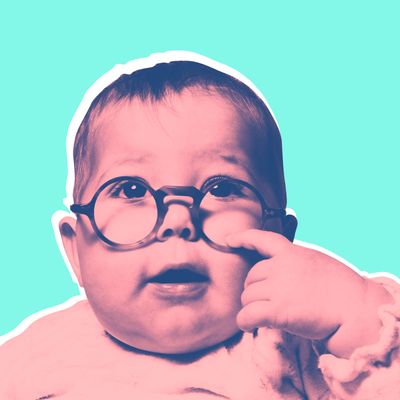
There are some things in this world that derive their cuteness from the fact that they’re just a little bit off in some way. Animals befriending members of other species. Pieces of furniture too tiny to do anything but sit in the palm of your hand. The droopy face of a blobfish. Babies wearing glasses, one of the small and surprising joys of this often-terrible world.
That’s true, you’re thinking right now. That’s pretty cute. And it’s an evergreen question: Why do adults go so nuts over babies wearing glasses? Or, okay, we know why — it’s because a tiny human wearing tiny spectacles is freaking adorable — but why is that the case? We asked Tokyo Gakugei University professor Joshua Paul Dale, co-editor of the book The Aesthetics and Affects of Cuteness and founder of a field of scholarship he calls “cute studies,” to explain, because honestly, don’t you want know?
Because it makes their eyes look bigger.
This one’s pretty intuitive — big eyes are cute, bigger eyes even more so — but there’s science to back it up. In the 1940s, the zoologist Konrad Lorenz outlined a kinderschema, or “baby schema” — a set of six physical traits that, in highly scientific terms, give you that awww feeling that makes you want to squeeze something. They are: “(a) large head relative to body size, rounded head; (b) large, protruding forehead; (c) large eyes relative to face, eyes below midline of head; (d) rounded, protruding cheeks; (e) rounded body shape; and (f) soft, elastic body surfaces.”
As Dale notes, plenty of studies over the decades have supported the existence of baby schema, and it’s the second element of Lorenz’s list that comes into play here: Certain lenses can magnify those giant baby eyes; in any case, glasses draw attention to just how big they are.
Because it helps us feel connected.
The prevailing view of cuteness is that it’s a sneaky evolutionary tool that keeps adults interested in caretaking; one 2016 review paper, for instance, called it a “potent protective mechanism that ensures survival for otherwise completely dependent infants.” In recent years, though, some researchers have proposed that that isn’t quite the full story — that babies benefit from their baby schema not just because of the protective instincts it inspires, but because it helps with their needs for socialization. (When’s the last time you tried to play peek-a-boo games with something you didn’t find adorable?)
“Feeling a baby is cute means we want to engage to help socialize him/her, and glasses are a sign of wanting to see the world more clearly in order to form attachments,” Dale says. “So we may see the glasses as a signal that the baby wants to reach out and engage with us, which is a fundamental part of the appeal that all cute objects make.”
Because it’s a study in opposites.
There’s a sort of thrill-seeking element to cuteness, Dale explains: “People who like cute things are always looking for new ways to experience this pleasurable feeling.” Think about ugly-cute as an example – it’s an unusual, unexpected way of having an otherwise familiar experience.
Along the same lines, he says, “we can consider glasses on a baby to be something novel and unexpected that creates a new category of cute things to enjoy.” Glasses, typically, are something we mentally sort into the category of “things adults wear,” and they carry connotations of things babies are too young to claim: vision problems, bookishness. So “the fact that glasses are a rather oppositional elemen – in that they connote adult behavior and mien, such as deep thought and that fact that we’re used to thinking that eyes weaken with age – ends up adding to the baby’s overall cuteness rather than subtracting from it,” he explains. In other words, it’s all about the incongruity.
But Dale shoots down another theory I asked him about — could it be that glasses made babies look like tiny adults, feeding in to our love of miniature things? — by pointing out that the premise is flawed. “We’re drawn to miniatures because they are perfect replicas of a larger object,” he says, “but babies are far from this.” It’s a fair point: A bespectacled baby is going to be a chubbier, lumpier, rosy-cheeked-er glasses-wearer than an adult in the same frames.
Besides, he adds, when we do try to make babies and little kids actually look adultlike, the results are more jarring than anything else: “Paintings of young children in the medieval period look like miniature adults, and they’re not cute at all.” (Julia Leyda, one of Dale’s co-editors on the Cuteness book and a professor of media studies at the Norwegian University of Science and Technology, points to beauty pageants as another example.) The sweet spot, it seems, is sticking a tiny human in just one of the trappings of adulthood without going overboard. May we recommend sunglasses?




